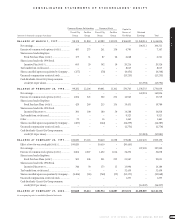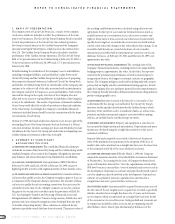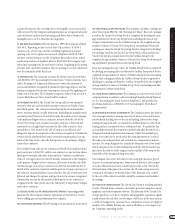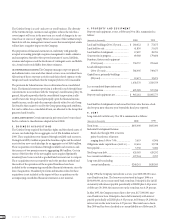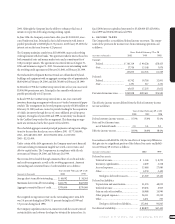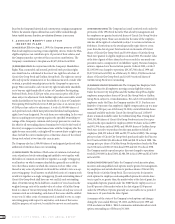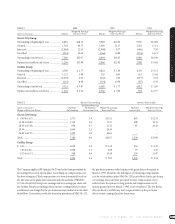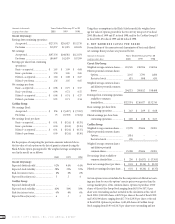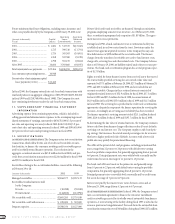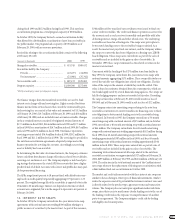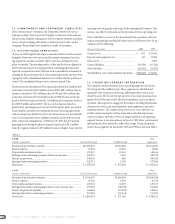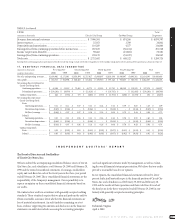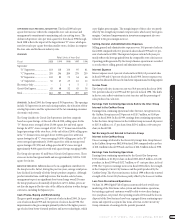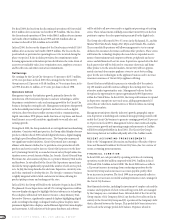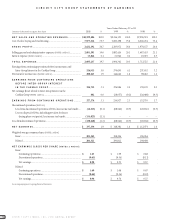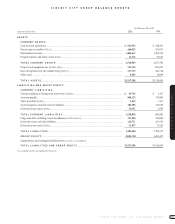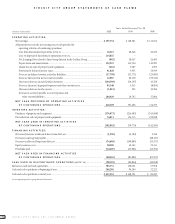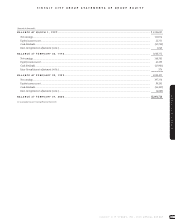CarMax 2000 Annual Report Download - page 45
Download and view the complete annual report
Please find page 45 of the 2000 CarMax annual report below. You can navigate through the pages in the report by either clicking on the pages listed below, or by using the keyword search tool below to find specific information within the annual report.
CIRCUIT CITY STORES, INC. 2000 ANNUAL REPORT 43
CIRCUIT CITY STORES, INC.
during fiscal 1999 and $123 million during fiscal 1998. This auto loan
securitization program has a total program capacity of $500 million.
In October 1999,the Company formed a second securitization facility
that allowed for a $644 million securitization of auto loan receivables in
the public market. The program had a capacity of $559 million as of
February 29, 2000, with no recourse provisions.
Receivables relating to the securitization facilities consist of the following
at February 29 or 28:
(Amounts in thousands) 2000 1999
Managed receivables .......................................... $ 931,745 $589,032
Receivables held by the Company:
For sale.......................................................... (23,477) (14,690)
For investment*............................................ (21,096) (35,342)
Net receivables sold............................................ $ 887,172 $539,000
Program capacity ............................................... $1,059,500 $575,000
*Held by a bankruptcy remote special purpose company
The finance charges from the transferred receivables are used to fund
interest costs,charge-offs and servicing fees. Rights recorded for future
finance income from serviced assets that exceed the contractually speci-
fied servicing fees are carried at fair value and amounted to $15.5 million
at February 29, 2000, $14.7 million at February 28,1999,and $6.8 million
at February 28,1998,and are included in net accounts receivable. Changes
in these retained interests consisted of originated retained interests of
$17.5 million in fiscal 2000,$16.6 million in fiscal 1999 and $7.3 million
in fiscal 1998,less amortization of $16.7 million in fiscal 2000,$8.7 million
in fiscal 1999 and $3.6 million in fiscal 1998. The finance operation’s
servicing revenue totaled $36.9 million for fiscal 2000,$28.2 million for
fiscal 1999 and $11.2 million for fiscal 1998. The servicing fee specified in
the auto loan securitization agreements adequately compensates the
finance operation for servicing the accounts. Accordingly, no servicing
asset or liability has been recorded.
In determining the fair value of retained interests,the Company estimates
future cash flows from finance charge collections,reduced by net defaults,
servicing cost and interest cost. The Company employs a risk-based pric-
ing strategy that increases the stated APR for accounts that have a higher
predicted risk of default. Accounts with a lower risk profile also may qual-
ify for promotional financing.
The APRs range from 6 percent to 18 percent fixed,with default rates vary-
ing based on credit quality,but generally aggregating 0.75 percent to 1.25
percent. The weighted average life of the receivables is expected to be in the
18 month to 20 month range. Interest cost depends on the time at which
accounts were originated,but is in the range of 6.4 percent to 6.6 percent at
February 29, 2000.
13. INTEREST RATE SWAPS
In October 1994,the Company entered into five-year interest rate swap
agreements with notional amounts totaling $300 million relating to a
public issuance of securities by the master trust. As part of this issuance,
$344 million of five-year,fixed-rate certificates were issued to fund con-
sumer credit receivables. The credit card finance operation is servicer for
the accounts,and as such,receives its monthly cash portfolio yield after
deducting interest,charge-offs and other related costs. The underlying
receivables are based on a floating rate. The swaps were put in place to
better match funding costs to the receivables being securitized. As a
result,the master trust pays fixed-rate interest,and the Company utilizes
the swaps to convert the fixed-rate obligation to a floating-rate,LIBOR-
based obligation. These swaps were entered into as part of the sales of
receivables and are included in the gain on sales of receivables. In
November 1999,these swaps terminated as the related securities in the
master trust matured.
Concurrent with the funding of the $175 million term loan facility in
May 1995, the Company entered into five-year interest rate swaps with
notional amounts aggregating $175 million. These swaps effectively con-
verted the variable-rate obligation into a fixed-rate obligation. The fair
value of the swaps is the amount at which they could be settled. This
value is based on estimates obtained from the counterparties, which are
two banks highly rated by several financial rating agencies. The swaps are
held for hedging purposes and are not recorded at fair value. Recording
the swaps at fair value at February 29, 2000, would result in a loss of
$90,000,and at February 28, 1999, would result in a loss of $2.2 million.
The Company enters into amortizing swaps relating to the auto loan
receivable securitization to convert variable-rate financing costs to fixed-
rate obligations to better match funding costs to the receivables being
securitized. In November 1995,the Company entered into a 50-month
amortizing swap with a notional amount of $75 million and,in October
1996,entered into a 40-month amortizing swap with a notional amount
of $64 million. The Company entered into four 40-month amortizing
swaps with notional amounts totaling approximately $162 million during
fiscal 1998, four 40-month amortizing swaps with notional amounts
totaling approximately $387 million in fiscal 1999,and four 40-month
amortizing swaps with notional amounts totaling approximately $344
million in fiscal 2000. These swaps were entered into as part of sales of
receivables and are included in the gain on sales of receivables. The
remaining total notional amount of all swaps related to the auto loan
receivable securitization was approximately $327 million at February 29,
2000,$499 million at February 28, 1999, and $224 million at February 28,
1998. The reduction in the total notional amount of the CarMax interest
rate swaps relates to the replacement of floating rate securitizations with
a $644 million fixed-rate securitization in October 1999.
The market and credit risks associated with these interest rate swaps are
similar to those relating to other types of financial instruments. Market
risk is the exposure created by potential fluctuations in interest rates and
is directly related to the product type, agreement terms and transaction
volume. The Company does not anticipate significant market risk from
swaps,since their use is to match more closely funding costs to the use of
the funding. Credit risk is the exposure to nonperformance of another
party to an agreement. The Company mitigates credit risk by dealing
with highly rated counterparties.


